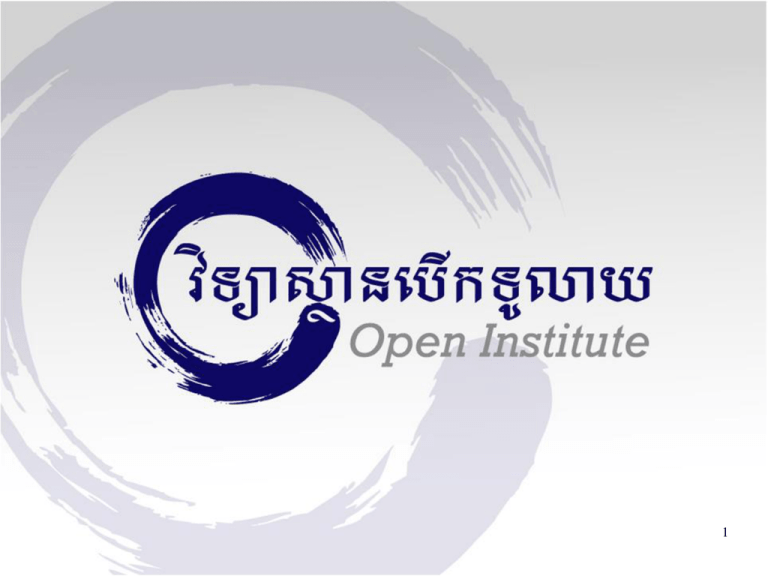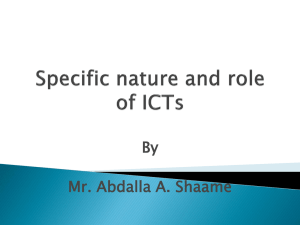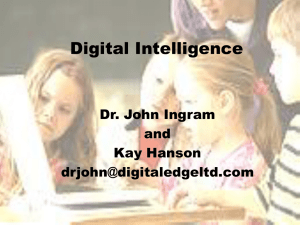
1
THE USE OF USHAHIDI AND
WOMEN WEB PORTAL
Open Institute, Phnom Penh,
Cambodia
29,30,31 January 2013
2
Gender and ICT4D
Cambodia Perspective
Ms. CHIM Manavy
Executive Director
Open Institute
3
About the Open Institute
Program Activities:
Structuring Partnership for an Innovative
Communications Environment (SPIDER)
http://www.open.org.kh/en/spice
Khmer Software Initiative (KhmerOS),
www.khmeros.info
Open School Program
http://www.open.org.kh/en/osp
Research
Women Empowerment for Social Change
(Women), http://women.open.org.kh
Dialogue on Democracy
Gender Base Violence (GBV)
Promote Access to Info to Women
April 8, 2015
4
About the Open Institute
The Mission is to ensure that the
benefits of technology for social and
economic advance are usable in
Cambodian society.
One among our main goals is to
improve social and gender equality
through advocacy and the promotion of
information sharing and
communication.
5
About the Open Institute-Networking
At international level, the Open Institute is a
member of the APC
At national level the Open Institute is:
• a partner of the MoWA, MoEYS, Buddhism
Institute.
• a
Steering
Committee
Cambodian NGO CEDAW
member
of
• a member of Gender Technical Working
Group (GTW-G).
Member of ICT4D network Cambodia
Member of CWEA
April 8, 2015
6
About the Open Institute-supported agencies
April 8, 2015
USAID is our main donor
Spanish Agency for International
Cooperation and Development
(AECID)
Association for Progressive
Communications (APC) .
Swedish Program for ICT for
Developing Regions-SPIDER
Open Society Institute (OSI) NY
Intel Tech
7
What are ICTs
Information
communication
technologies
(ICT), broadly means tools and platforms
that we use for our communication and
information needs. Some examples include
radio,
mobile
telephones,
television
broadcasts, and the internet.
Sometimes ICT are understood in "old" and
"new" forms. Simply put, "older" forms of
ICT are where information is transmitted in
analogue format like radio, and "newer"
forms of ICT are those transmitted in digital
formats like wireless technology.
April 8, 2015
8
History of Gender and ICTs for
Development
The roots of ICTs for development lie in the
1970s
assertion
that
economies and
societies were being revolutionized not
by industry but by the information and
knowledge that were critical to securing the
means of production
But ICTs are not unique in that women are
disadvantaged relative to men in terms of
their access to all types of modern technology
These issues make discussions of the gender
gap in the ‘digital divide’
April 8, 2015
9
History of Gender and ICTs for Development
There is a risk that the gender gap remains.
As Hafkin and Taggart (2001) have explained, this
bias is evident in three ways:
(1) women are rarely involved in
assessment of ICTs for development;
the
needs
(2) attitudes that high-end information technology
‘is not for women’ who are still being treated as
passive recipients of information and not as active
information users and communicators;
(3) there is considerable delay in addressing the
limitations
faced
by
women
in
accessing
supposedly ‘public’ information spaces, or even
private sector initiatives such as cyber-cafes.
“ Gender, Society & Development , Gender & ICTs 4D”,
April 8, 2015
http://publication.oxfam.org.uk/oxfam/display.asp?ISBN=0855985658
10
History of Gender and ICTs for
Development
‘
Policymaking for gender and ICTs for
development or engendering ICT policy has
been attempted:
The first approach has largely emerged from
academics
the second from ‘gender mainstreamers’
within or close to the UN system
Third from developed and developing
country feminists in civil society
April 8, 2015
11
History of Gender and ICTs for
Development
In the early 1990s, under the auspices of the
United Nations Commission on Science and
Technology for Development (UNCSTD) and
UNIFEM’s (United Nations Fund for Women)
preparation for the Fourth World Conference on
Women in Beijing in 1995
UN
ICT
Task
Force,
the
International
Telecommunication Union (ITU) and the World
Summit on the Information Society (WSIS)
WSIS first meeting in 2003, second meeting in
2005-WSIS Gender Caucus .
April 8, 2015
12
History of Gender and ICTs for
Development
Third approach to gender and ICTs led by
feminists active in civil society in developing
and developed countries
Thematic sessions have been held at the World
Rural Women’s Congress (Spain, 2002) and civil
society have engaged in the WSIS Gender
Caucus regional consultations.
Initiatives such as the Women’s Networking
Support Programme (WNSP) of the Association
for Progressive Communication (APC)
donors are already committed to funding and
implementation of a common set of eight
Millennium Development Goals (MDGs)2000.
April 8, 2015
13
Why Gender and ICT4D-Beijing
Declaration and Platform for Action
Fourth World Conference on Women, Beijing
Sept.1995- Beijing Declaration and Platform of
Action: Women in media
Strategic
objective
J1:
Increase
the
participation
and
access
of
women
to
expression and decision-making in and through
the
media
and
new
technologies
of
communication. Actions to be taken.
Strategic objective J2:Promote a balanced and
non-stereotyped portrayal of women in the
media. Actions to be taken.
April 8, 2015
14
Gender and ICT4D-Concluding Comment of the
Committee on the Elimination of Discrimination
against women
Article 38. The Committee on the Elimination
of Discrimination against women urges the
State party to utilize fully in its implementation
of its obligations under the Convention, the
Beijing Declaration and Platform for Action,
which reinforce the provisions of the
Convention, and requests the State party to
include information thereon in its next periodic
report.
April 8, 2015
15
Relation between gender,VAW and ICT4D
ICTs are clearly not ‘gender neutral’ because
women are less involve in ICT if compare to men.
Women know the importance of information and
the power that these technologies hold .
Toward the MDGs, to call for fully implementation
of the CEDAW and the Beijing Platform of Action.
Women are not waiting for policymaking to
bridge the ‘digital divide’ but rather take
action as agents of their own opportunities using
conventional ICTs such as radio, telephone, to
access information sources and communication
processes to achieve their development goals.
April 8, 2015
16
Relation between gender,VAW and ICT4D
Worldwide, women’s organisations and networks
are using online resources, websites, and
chatrooms to share experiences, to mobilize
support for specific actions and develop global
action strategies.
By examining how ICTs have been employed,
women's
movements
can
shape
stronger
connections with greater understanding of their
potential and limitations.
Secure online spaces enable survivors of violence
against women to communicate their situation
and seek help. What is clear and must be a
priority is that women are informed, aware and
involved in the discussions and debates that must
take place around these emerging trends in
April
8, 2015
17
Internet
Relation between gender , VAW and ICT4D
But there is also an increasing recognition
of the connection between VAW&ICT. E.g
web sites or mobile phones can be a useful
place for women in violent relationship to
obtain information and assistance; at the
same time, tools like spyware and global
positioning system (GPS) tracking devices
have been used by abusers to track and
control their partner’s mobility.
Using Internet tool for trafficking or use
mobile phone to abuse women.
April 8, 2015
18
Relation between gender,VAW and ICTs 4D
Women are concerned:
Some groups of people have been using ICTs
for other purposes that are against human
rights.
For example:
Khmer sex video on CDs can
be brought from the road and in public
places for less than $1/CD,
pornography
image transmission from phone to phone,
image trafficking, personal data security
violation, etc
Women are negative portrayed
objective of violence.
April 8, 2015
and is an
19
Relation between gender,VAW and ICTs 4D
Print and electronic media in many countries,
including Cambodia do not provide a balanced
picture
of
women's
diverse
lives
and
contributions to society in a changing world.
In
addition,
violent
pornographic
media
negatively
affecting
participation in society
and
degrading
or
products
are
also
women
and
their
The world- wide trend towards consumerism
has created a climate in which advertisements
and commercial messages often portray
women primarily as consumers and target girls
and women of all ages inappropriately.
April 8, 2015
20
Relation between gender,VAW and ICTs 4D
The growth of the Internet is pushing the limits of a
society's attitudes towards acceptable media
images, through exploitative use of images taken
for private consumption.
Technology is moving across boundaries faster than
the law can address.
At the same time, ICT use in general, much less
awareness of how ICTs can be strategically used to
combat violence against women, is very limited in
Cambodia.
Most Cambodian women are not familiar with the
use of ICT
April 8, 2015
21
Relation between gender,VAW and ICTs 4D
Where are women voices through media?
Traditional tools use for communication such as
telephone, radio is common to Cambodian women
Most women are not able access the ICTs, equal to:
-Not access
information
to
the
pool
-Women are marginalized
world
of
knowledge
and
from the rest of the
-are not in the progress of the fundamental of
human needs outlined in the MDGs
-lack of opportunities for raising awareness of their
vulnerability and the need for action to ensure their
safety
April 8, 2015
22
Gender and ICT4D
Therefore:
Access to ICT can be seen as a central
issue concerning the empowerment of
women.
There is no worse form of human rights
violation than to be deprived of the
ability to think, create and communicate
in freedom.
April 8, 2015
23
Cambodian Context
Some have said ICT is gender-neutral.
But in Cambodian context, "within
the given social and economic
structure, gender roles and relations,
women and men cannot get equal
access to ICT”
April 8, 2015
24
Women & ICT Status in Cambodia
The lack of access to ICT because of
societal,
cultural
and
market
constraints have led women to
become distant from the global pool
of information and knowledge.
Reasons for less representation of
women holding jobs in ICT fields
included lower percentage of female
student's enrollment in IT related
education
April 8, 2015
25
ICT Infrastructure
April 8, 2015
26
27
Result of Research on Women & ICT in
Education and Employment
Women & ICT in Education
The percentage of female graduated in ICT
related
field
was
lower
than
male
counterparts.
The total of female who get the bachelor
degree of ICT in the last four years'2005 to
2009' was 12.4% of total student in ICT if
comparing with 8.4% of the proportional of
female students who has been studying ICT
of the 1st year to the 4th year of the year
2009-2010 .
April 8, 2015
28
Result of Research on Women & ICT in
Education and Employment
Women & ICT in Employment
The proportional of women in ICT' jobs:
The percentage of women can use ICT
in civil society is 44.4% of total staff,
government and ministries is 15.5%,
Internet Service Provider is 32.5%
and Education Institution is 33.3%.
April 8, 2015
29
Result of Research on Women & ICT in
Education and Employment
A study on Women and ICT in Education and
Employment in 2010 found that only less than
1/4 of NGOs (22.5%), 9% of HE institutes,
14% of
ISPs and 35% of government
ministries have a policy implemented to
encourage women to build their own capacity
in the ICT sector.
This status will not have much changed in the
near future because for the rest of them, there
are only 23% of NGOs, 41% of government
ministries, 21% of ISPs 21%, and 21% HE
institutes are willing to design a policy to
encourage ICT skills & capacity building for
women (MOWA et.al 2010).
April 8, 2015
30
Result of Research on Women & ICT in
Education and Employment
The challenges of women in ICT development:
Family responsibility such as take care
husband, children, elderly person in family
(66%).
Female get less opportunities than male in
getting chance to study more (64%).
State policy and sectoral implementation
(60%), Language (57%).
Infrastructure (53%), High cost of Internet
(52%).
April 8, 2015
31
Recommendations
The government should further build necessary ICT
infrastructure throughout the country.
Should create ICT and English subjects starting from
primary school.
Should encourage
women joint ICT sectors by
discount school fee , give more opportunities in
getting scholarship in ICT fields.
Should have Education Research council to estimate
and finding the root cause of female who has
graduated ICT face with the difficulties in getting
ICT jobs.
All Institutions and companies should have special
policies in getting women who has just graduated
involved in their employment.
April 8, 2015
32
33
Gender Perspective on ICT Policy
Development- Consultative meetings
The co-organizers were: The Open Institute, The
Ministry of Post and Telecommunications (MPTC)
End Child Prostitution, Abuse and Trafficking in
Cambodia (ECPAT/Cambodia)
People Health and Development Association (PHD)
Rural Development Association (RDA)
The consultation meetings were divided into three
steps: 1) pre-consultation held on 4 May 2011 at Open
Institute office; 2) first consultation meeting held on
19 May 2011 at Sunway Hotel; and 3) second
consultative meeting held on 31 May 2011 at Sunway
Hotel
April
8, 2015.
34
Gender Perspective on ICT Policy DevelopmentConsultative meetings (continue)
April 8, 2015
35
Gender Perspective on ICT Policy DevelopmentConsultative meetings (continue)
April 8, 2015
36
Gender Perspective on ICT Policy DevelopmentConsultative meetings (continue)
Out of the 11 objectives set out in the National
ICT draft Policy, ‘gender implication’ has been
numbered as the 10th objective, ‘Enforce the
Women in Development (WID) within the scope
of ICT’. In order to achieve its objectives by
2015, five main pillars have been incorporated
into the National ICT Policy.
April 8, 2015
37
Gender Perspective on ICT Policy DevelopmentConsultative meetings (continue)
The WID has been included in pillar four. The
pillar states that women will be considered to be
included in the process of developing the ICT
sector and play roles in the pool of ICT experts
for the industry and other related sectors.
April 8, 2015
38
Gender Perspective on ICT Policy DevelopmentConsultative meetings (continue)
This process was developed in order to align it
with the International Convention on the
Elimination of All forms of Discrimination Against
Women (CEDAW). It stated that both sexes are
equal and therefore shall be equally treated in the
workplace.
It has also to comply with the Cambodia
Millennium Development Goals 3 (CMDG3) to
promote gender equality and empowerment of
women.
April 8, 2015
39
Results of consultative discussion:
ICT development is not widely discussed,
particularly looking on the issue at a gender
glance. It is imperative that Cambodia should
have ICT policy for each sector in which
gender perspective should be mainstreamed in
the sector and in the national ICT policy.
April 8, 2015
40
Results of consultative discussion (continue):
Technical Working Group on Gender (TWG-G),
an existing mechanism of the government will
be a good entry point for the promotion and
integration of gender perspective into ICT
policies.
There is also a concern over the abuse of
women and children in the ICT sector in which
the future cyber law need to response the
issue.
April 8, 2015
41
Results of consultative discussion: (Continue)
It is recommended that women should be
encouraged in ICT skills capacity building, in
the development of ICT sector and in labor
market.
Local content and local language should be
promoted so that women can benefit from ICT
evolution.
Looking at regional level, Cambodia's ICT
policies should align with the ASEAN framework
(ASEAN ICT Master Plan 2015).
April 8, 2015
42
Best Practice
The use of new technology ( the Internet) and the
mobile phone is booming in Cambodia by young
group: users of blogger, face book, twitter,etc
Some NGOs in Cambodia have been used ICTs for
women rights and combating GBV,VAW:
LICADHO,CWCC, MoWA, VOD, CCHR,CLEC,etc.
WMC the single women radio
The Open Institute, the first web portal for
women in Khmer.
Video documentaries, Video drama, Websites,
Women web portal, Radio show, TV...
April 8, 2015
43
April 8, 2015
44
April 8, 2015
45
Best Practice-Gender Based
Violence data base
46
Best Practice-Women web portal
47
TBTT Campaign 2008 in Cambodia
Under the cooperation with the
UNIFEM in New York, UNIFEM in
East Asia and South East Asia,
and UNIFEM in Cambodia, the
women program localized and
posted the template “Say NO to
violence against women” to the
Women Web Portal to invite
visitors to join the event by
provide their signatures to
support the campaign.
April 8, 2015
48
Best Practice-Blog
t
April 8, 2015
49
Best Practice-online forum
April 8, 2015
50
Best Practice-Gender Mailing list
t
April 8, 2015
51
Conclusion/Recommendations
Access to ICTs can be seen as a central issue
concerning empowerment of women.
Women should be empowered by enhancing their
skills, knowledge and access to information
technology.
Investment in women empowerment through the
use of ICTs is equal to social development
52
Conclusion/Recommendations
Beijing Platform of Action:
ICTs skills and knowledge will strengthen their
ability to combat negative portrayals of women
nationally and internationally, and to challenge
instances of abuse of the power of an increasingly
important industry.
Women therefore need to be involved in decision
making regarding the development of the new
technologies in order to participate fully in their
growth and impact.
53
Conclusion/Recommendations
The shortening the gap of gender divide should be
link to the progress on the most fundamental of
human needs outline in the MGDs.
It is imperative from the perspective of gender and
ICTs4D that focus be placed on gender relations in
communication and learning rather than simply
women and technology or women and media.
The information society is not an end itself, but
rather, the innovation of ordinary people including
ordinary women.
54
Thank You
Open Institute, http://www.open.org.kh
http://www.women.open.org.kh
April 8, 2015
55








